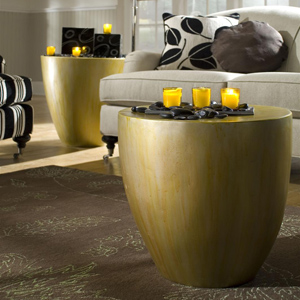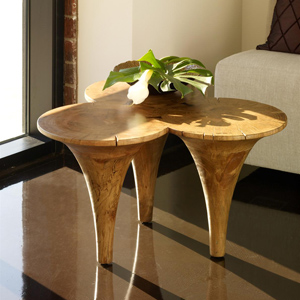Since accent tables are available in a variety of sizes and shapes, placement is key. Photo: Phillips Collection
Lighting Your Accent Tables
To make the best use of your space, place a floor lamp near or behind an accent table rather than placing a table lamp on it.
Table Talk
Here are a few popular styles of accent tables.
Contemporary: Look for odd shapes, clean lines, black and bold colors, and metal, chrome, acrylic and glass.
Cottage: You’ll recognize these tables by their painted finishes, garden-inspired colors, friendly shapes and relaxed feel.
Mission: Born out of the Arts and Crafts Movement of the early 20th century, this style incorporates elements from nature by using wood finishes, autumn colors, clean lines and simple shapes.
Traditional: Typically more formal and decorous, these tables are easily identified by their rich wood finishes, such as mahogany and cherry; curvy shapes; and often ornate carvings.
Transitional: A blend of traditional and contemporary, with a more casual feel, these accent tables are flexible, comfortable, practical, and stylish.
-
Accent on Style
These fun little tables pack big design punch.
- by Mary Best
Accent tables are a great way to accessorize your home and complement your style and personality. These small, decorative tables can punctuate a room and add an expressive finishing touch.
“Accent tables add interest to a setting and help further develop the room's story," says John Scott, CEO and founder of Atlanta-based Sterling Industries. “They serve to either enhance the existing theme or bring another element—like color or texture—into play."
The Right Shape
Unlike larger coffee tables and sofa tables, accent tables can be used in a number of places throughout a room. The challenge is to know where accent tables are best placed and how they are best used. And since they are available in a variety of sizes, shapes and colors, placement is key.
Scott says that accent tables are perfect next to a chair, beside a fireplace, between two chairs or at the end of a sofa. He also suggests that you look at your room with an analytical eye. Make sure you have a healthy balance of round, rectangular and square shapes to create the best room setting.
Mix it Up
Scott also points out that while end tables in a living room or den do not have to match (as was the trend in years past), they should match in feeling and style. For example, you can blend painted wood with natural wood finishes to create an eclectic look.
Mixing and matching different design approaches continues to be a popular trend in home décor, and works well for selecting accent tables. Natural materials, such as travertine tabletops and distressed woods, are in demand, says Scott. “Homes are more casual these days and thus demanding the warm rubbed finishes.”
For a more eclectic or transitional look, incorporate accent tables that have sleeker and cleaner lines—with glass or a smooth polished metal accent. Nesting tables (smaller tables that stack underneath larger ones) are also a great choice because they are functional and visually interesting.
Get Creative
Selecting accent tables offers you a wonderful opportunity to be creative and adventurous with your décor. Ultimately, when looking for your perfect accent table, you'll need to consider the style and function of your room, as well as your personal design taste—but be open to new looks and finishes that might not appeal to you in a larger piece. In doing so, you can add unexpected flair to your home.



